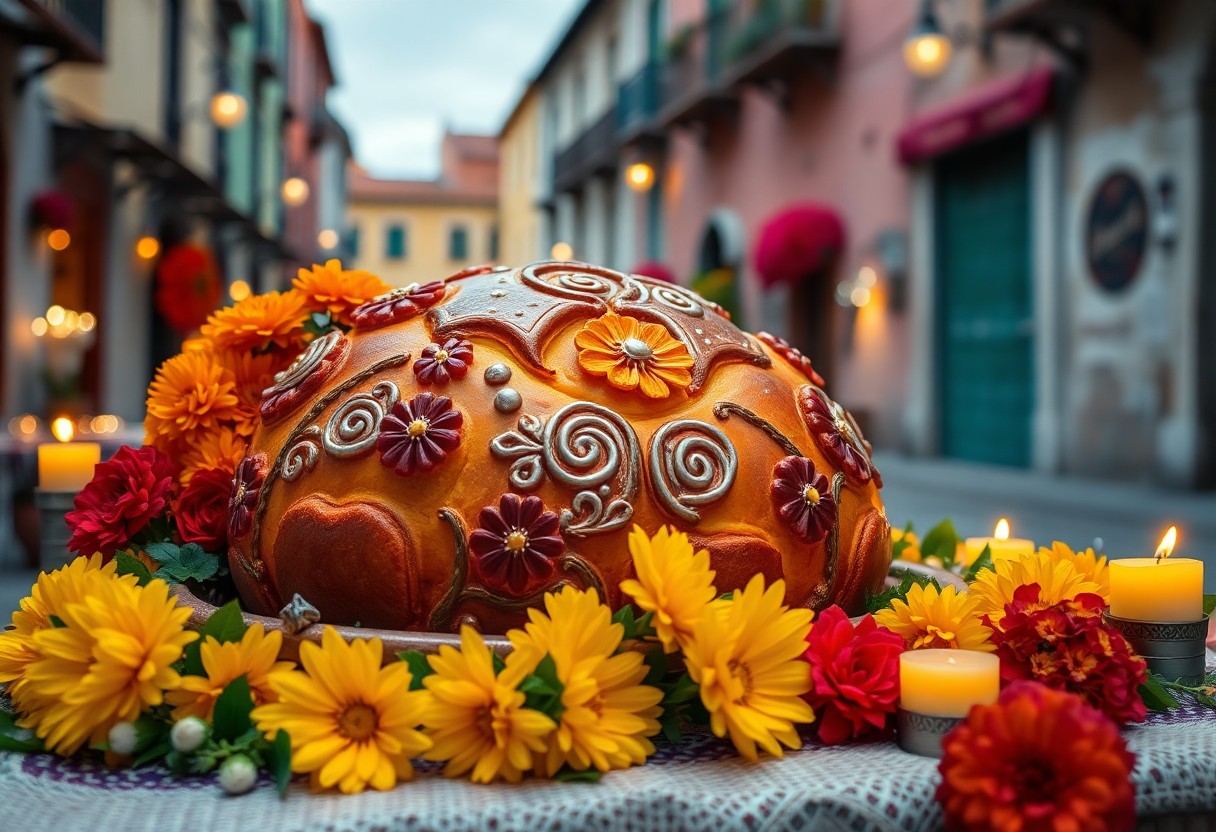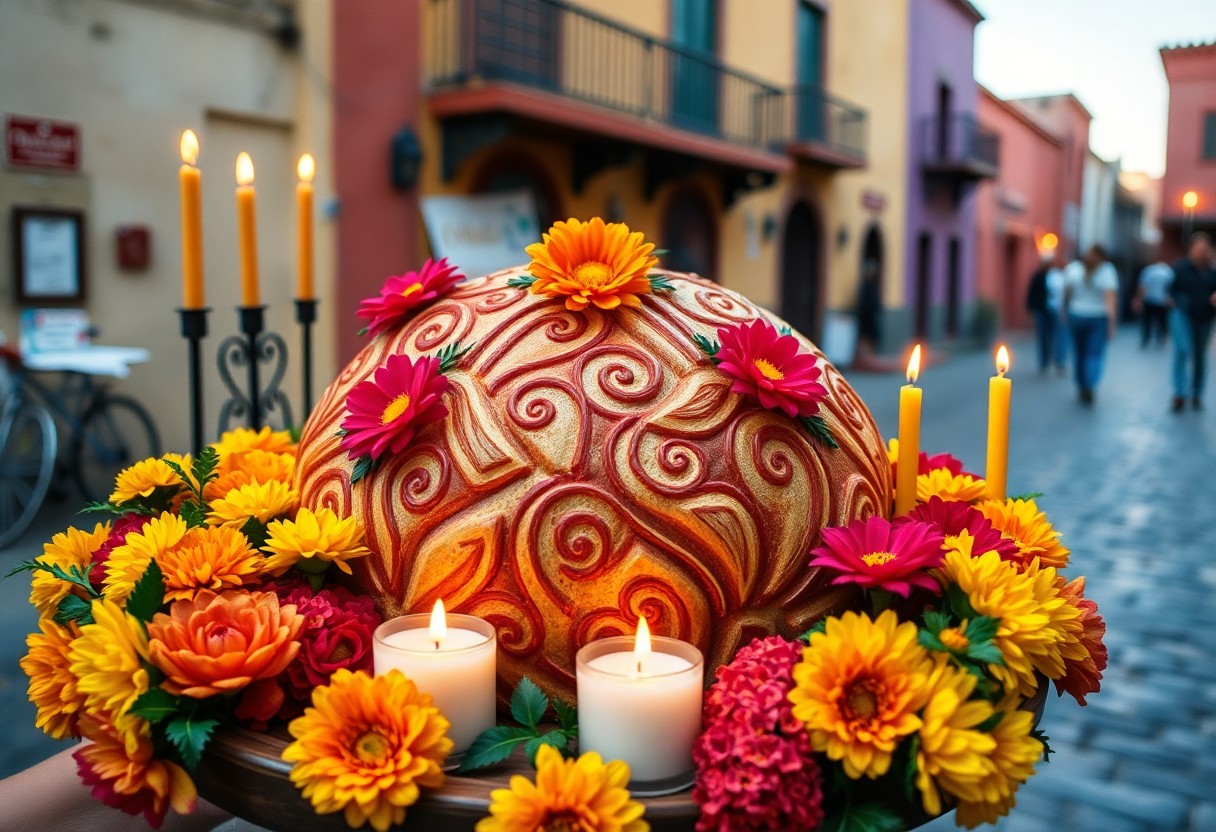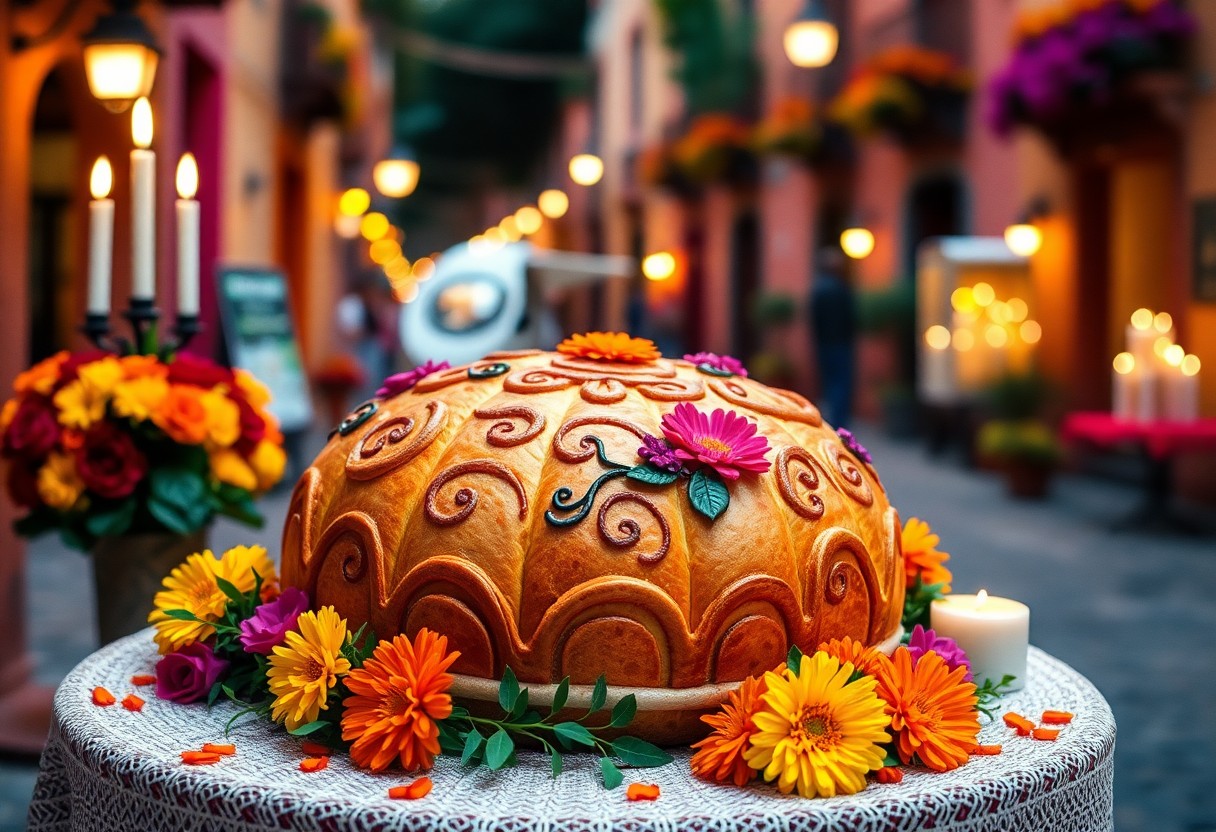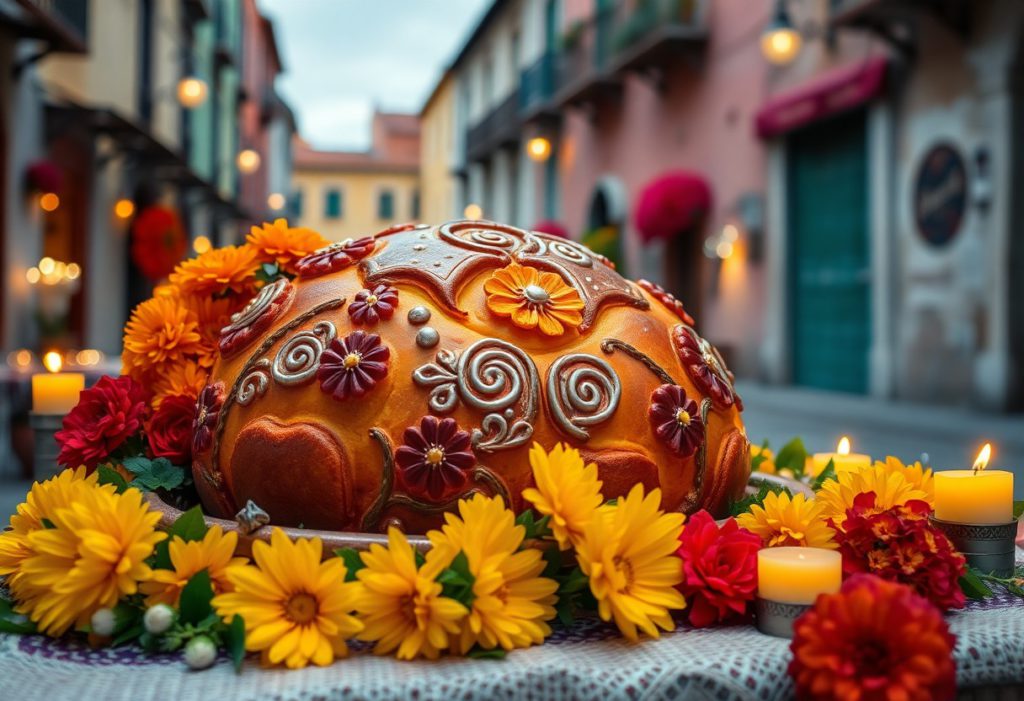As you stroll through the vibrant streets of <a href=”https://fallinginlovewithsanmiguel.com/la-catrina-a-day-of-the-dead-icon/”>San Miguel de Allende</a> during the colorful festivities of Día de Muertos, the enchanting scent of freshly baked Pan de muerto fills the air. This iconic bread represents more than just a delicious treat; it serves as a heartfelt tribute to those who have passed away, embodying a cherished tradition that resonates deeply within Mexican culture. In San Miguel de Allende, this exquisite delicacy is prepared with great care, blending local flavors with ancient customs that reflect the essence of the community. Discover the profound connections that this bread fosters and why savoring it is an essential part of your experience during your visit.

Delve into the Fascinating History of Pan de Muerto
Pan de muerto stands as a poignant emblem of Mexico’s rich cultural tapestry, with its roots tracing back to ancient pre-Hispanic rituals. The ancient Aztecs honored their deities with bread made from amaranth, a sacred grain that held spiritual significance. With the arrival of Spanish colonizers, new ingredients such as wheat flour and European baking techniques were introduced, resulting in a unique fusion of indigenous and colonial baking traditions. Over the centuries, this blend has evolved into the iconic bread we celebrate today, intricately linked to the Día de Muertos festivities. In San Miguel de Allende, this beloved tradition continues to flourish, as local bakeries passionately create pan de muerto, offering both a delectable experience and a heartfelt homage to the departed.
Trace the Evolution of Pan de Muerto Through Generations
Although pan de muerto has long been a staple of the Día de Muertos observances, its recipe and presentation have undergone remarkable changes throughout the years. Initially, it was a simple loaf made from basic ingredients like flour and water. As time went on, bakers in San Miguel de Allende and throughout Mexico began to enhance the flavor by incorporating elements such as orange blossom water, anise, and butter, which noticeably improved its taste and texture. The distinctive design of crossed bones, symbolizing the eternal cycle of life and death, emerged as a hallmark of this tradition. Today, you can find various modern adaptations, including chocolate-infused or fruit-stuffed versions, all while still honoring the cherished customs that define this beloved bread.

Explore the Regional Variations of Pan de Muerto Across Mexico
Before diving into the diverse regional variations of pan de muerto, it’s vital to appreciate how this iconic bread reflects the vast culinary traditions of Mexico. Each region brings its own unique twist, resulting in a rich tapestry of flavors and designs that pay homage to the Day of the Dead in distinct and meaningful ways.
Experience the Classic Pan de Muerto of Mexico City and Central Mexico
The traditional pan de muerto from Mexico City and Central Mexico is widely celebrated for its delightful flavor. This version is often flavored with orange zest or orange blossom water, showcasing the traditional crossed bone design topped with a generous sprinkle of sugar. It holds a significant place on ofrendas and is treasured for its sweet taste and deep symbolic meaning, making it a must-have during the Día de Muertos celebrations.
Admire the Craftsmanship of Oaxacan Pan de Muerto
Few creations can rival the intricate beauty of Oaxacan pan de muerto. Renowned for its sweet and buttery flavor, this version frequently features elaborate decorative patterns adorning its surface, symbolizing the delicate balance between life and death. It transcends mere bread; it becomes a visual and culinary masterpiece that embodies the essence of Oaxacan culture.
The artistry of Oaxaca’s pan de muerto truly makes it stand out. The bread’s designs often incorporate flowers, crosses, or other significant symbols, rendering it a striking centerpiece on ofrendas. Its rich flavor and profound cultural significance make it an essential delight during your Day of the Dead festivities.
Discover the Symbolism in Michoacán’s Pan de Muerto
Characterized by its unique shapes, Michoacán’s pan de muerto often takes the form of human figures known as animitas, representing the souls of the departed. This variation is deeply imbued with symbolism, acting as a tangible connection between the living and their ancestors.
Michoacán’s pan de muerto is more than just a delicious treat; it serves as a heartfelt tribute to those who have passed. The animitas are crafted with great care and frequently adorned with vibrant decorations, placed on ofrendas to honor beloved family members. This tradition exemplifies the region’s profound respect for its cultural heritage.
Experience the Vibrant Interpretation of Yucatán’s Pan de Muerto
If you haven’t yet tried Yucatán’s pan de muerto, prepare for a delightful surprise. This version is infused with flavors of anise and coated in a sweet red glaze, creating a visually stunning appearance and a distinctive taste. It serves as a colorful addition to any ofrenda, reflecting the region's lively culture.
The pan de muerto from Yucatán embodies the vibrancy of its cultural backdrop. The red glaze symbolizes life and vitality, while the anise introduces a unique twist to the traditional recipe. Each bite serves as a flavorful reminder of the region’s rich customs and traditions.
Experience the Unique Flavor of Guanajuato’s Pan de Muerto
A vital part of Guanajuato’s Día de Muertos festivities is its pan de muerto, typically crafted using piloncillo (unrefined cane sugar). This ingredient contributes a deeper, richer flavor, setting it apart from other regional varieties and enhancing its appeal.
Bakeries in Guanajuato take great pride in their pan de muerto, skillfully combining traditional techniques with locally sourced ingredients. The inclusion of piloncillo adds a rich depth of flavor that reflects the culinary heritage of the region, making it an essential delicacy during your visit to San Miguel de Allende.

Grasping the Importance of Pan de Muerto in Día de Muertos Celebrations and Ofrendas
Your understanding of Día de Muertos in San Miguel de Allende deepens significantly when you acknowledge the critical role of pan de muerto in ofrendas. This cherished bread, often infused with orange blossom water or anise, is thoughtfully placed on altars to honor deceased loved ones. Its circular shape signifies the eternal cycle of life and death, while the crossed bones atop symbolize the bond shared between the living and the departed. By presenting pan de muerto as an offering, you nourish the spirits during their visit, forging a meaningful connection between the past and present. It’s a powerful tradition that preserves cherished memories.
Your Comprehensive Guide to Crafting Authentic Pan de Muerto at Home
Creating authentic Pan de Muerto is an engaging process that requires just a few essential ingredients and a touch of patience. This traditional bread, deeply rooted in the culture of San Miguel de Allende, offers a heartfelt way to connect with Día de Muertos traditions. Below, we present a detailed breakdown of the process, highlighting crucial steps to ensure your bread turns out perfectly.
Pan de Muerto Recipe Guide
| Ingredients | Steps |
| 4 cups flour | Combine flour, yeast, sugar, and salt in a mixing bowl. |
| 1/2 cup sugar | Incorporate warm milk, eggs, and orange zest, then knead the mixture until smooth. |
| 1/2 cup butter | Add softened butter and continue kneading for about 10 minutes. |
| 1/4 cup orange zest | Allow the dough to rise for 1-2 hours until it has doubled in volume. |
| 1/4 cup warm milk | Shape the dough into rounds and add bone-shaped decorations on top. |
| 2 eggs | Bake in the oven at 350°F (175°C) for 20-25 minutes or until golden brown. |
| 1 packet yeast | Brush with melted butter and sprinkle with sugar before serving. |
Important Notes: Ensure your yeast is fresh to achieve a dough that rises properly. Exercise caution when handling hot pans and ovens. The inclusion of orange zest and butter are key ingredients for achieving the authentic flavor of Pan de Muerto. Enjoy this special bread as an integral part of your Día de Muertos celebration in San Miguel de Allende, where tradition and flavor harmoniously intertwine.
Essential Tips for Enjoying Pan de Muerto in San Miguel de Allende
To ensure a delightful experience with pan de muerto in San Miguel de Allende, keep the following tips in mind:
- Visit local bakeries early in the morning to secure the freshest bread, as it tends to sell out quickly during the Día de Muertos season.
- Enhance the flavors of your pan de muerto by pairing it with a cup of hot chocolate or atole, a traditional Mexican drink.
- Explore the diverse regional variations, such as those flavored with orange blossom water or anise, to fully appreciate the richness of this iconic bread.
- Respect the cultural significance of pan de muerto by learning about its role in ofrendas and its importance in honoring those who have passed.
After enjoying your pan de muerto, take a moment to reflect on its profound connection to Mexican traditions and the celebration of life and death.
Common Questions About Pan de Muerto Answered
Q: What cultural significance does Pan de Muerto hold in San Miguel de Allende?
A: Pan de Muerto carries immense cultural importance in San Miguel de Allende, especially during Día de Muertos. It is a traditional pastry placed on ofrendas to honor deceased loved ones. The bread symbolizes the cycle of life and death, serving as a bridge between the living and the spirits of the departed.
Q: How does Pan de Muerto in San Miguel de Allende differ from variations in other regions of Mexico?
A: In San Miguel de Allende, Pan de Muerto often features local ingredients like piloncillo (unrefined cane sugar), resulting in a richer and denser flavor profile. The bread typically maintains the classic design with crossed bones on top, but local bakers may incorporate unique elements that reflect the traditions of Guanajuato.
Q: Where can I find the finest Pan de Muerto in San Miguel de Allende?
A: The finest Pan de Muerto in San Miguel de Allende can be found at local bakeries and markets, particularly during the Día de Muertos season. Many bakeries offer both traditional and regional varieties, providing visitors with an authentic taste of the area's rich cultural heritage.
The Article: Pan de Muerto: A Delicious Symbol of Tradition in San Miguel de Allende appeared first on https://fallinginlovewithsanmiguel.com/
The Article Pan de Muerto: A Delicious Tradition in San Miguel de Allende Was Found On https://limitsofstrategy.com


I love how you’ve captured the essence of Día de Muertos in San Miguel de Allende! The beauty of Pan de muerto extends beyond its rich flavors; it symbolizes the connection we maintain with those we’ve lost. When you share this bread, it’s like sharing a piece of history and culture that binds generations.
You’ve hit the nail on the head! Pan de muerto really is like a delicious bridge to our ancestors. Every time I share it, I can’t help but imagine my great-grandmother giving me a stern look for overindulging. It’s funny how bread can spark such a mix of emotions—joy, nostalgia, maybe a sprinkle of guilt. Plus, since it’s not just a treat, but a family tradition, I often wonder about the bread recipes being passed down—do they really know the secret ingredients, or is it just a bit of love mixed in with flour? Sharing it makes me feel like I’m part of a timeless narrative, one bite at a time. How do you usually enjoy your pan de muerto?